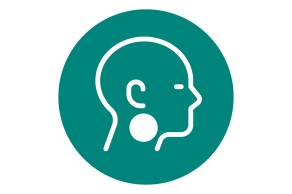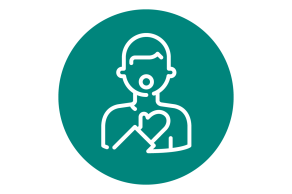AREAS OF OCCURRENCE
Cancers of the head and neck can occur in the following areas:1
ORAL CAVITY
PHARYNX
LARYNX
PARANASAL SINUSES AND NASAL CAVITY
SALIVARY GLANDS
The oral cavity consists of the lips, the front two-thirds of the tongue, the lining inside the cheeks and lips, the gums, the bottom of the mouth under the tongue, the hard top palate and the area of the gums behind the wisdom teeth.1
The pharynx (throat) is a hollow tube about 12,5 cm long that begins behind the nose and leads to the oesophagus.
It has three parts: the nasopharynx, the oropharynx and the hypopharynx.1
Also called the voice box, the larynx is a short passage formed by cartilage that sits just below the pharynx in the neck. The larynx contains the vocal cords and the epiglottis, which helps prevent food from entering the airway.1
The paranasal sinuses are small hollow spaces in the bones of the head that surround the nose. The nasal cavity is the hollow space inside the nose.1
The major salivary glands are in the floor of the mouth and near the jawbone. These glands produce saliva.1
RATE OF INCIDENCE
Head and neck cancers are a major public health concern worldwide. The incidence in less-developed regions is approximately double that of developed regions. The estimated incidence in sub-Saharan Africa is…2
27 593 per 100 000
SIGNS AND SYMPTOMS 3,4
The symptoms vary according to where the cancer began. General signs can include:

A mouth ulcer
A swollen or broken area of skin that will not heal. This is the most common mouth cancer symptom.

Lump in the neck, jaw or mouth
Lumps can also form in the lips. Cancer usually forms a lump that slowly gets bigger.

Weakness or pain in the face
Pain, discomfort, weakness or numbness in the head or neck area that persists.

Neck pain or nodules
Thyroid cancer can cause swelling or small painless nodules to form in the front of the neck.

Difficulty moving the jaw
Pain or difficulty chewing or moving the jaw or tongue. A tumour in this area can make it difficult to open your mouth.

Difficulty swallowing
A feeling that food is stuck in your throat or going down the windpipe. An urge to cough on food or liquid.

Speech problems
Change in the voice (quieter, husky, hoarse, etc.). Slurring or trouble pronouncing certain words/sounds.

Ear pain or hearing loss
Ear pain is common with throat cancer. It can cause ringing in the ears. Ear infections should be evaluated.

Persistent sore throat
Pain or discomfort in the throat that doesn’t go away is one of the most common symptoms of throat cancer.

Red or white patches
Patches that appear in the mouth or throat. These patches are not cancer, but may lead to cancer if left untreated.

Trouble breathing
Difficulty breathing, persistent nasal congestion or unusual discharge and frequent nosebleeds can be signs.

Unexplained weight loss
Head and neck cancers can make it difficult to swallow or painful to eat, which can result in weight loss.
RISK FACTORS 5,6
The risk factors include:
Tobacco
Tobacco use includes the use of snuff and chewing tobacco. People who are exposed to secondhand smoke are also at an increased risk of acquiring head and neck cancers. Smoking is the greatest risk factor for developing this type of cancer.

Alcohol
Drinking alcohol is a major risk factor for head and neck cancers.
Using tobacco and alcohol in combination increases the risk of head and neck cancer even more than using either of the two alone.

Human papillomavirus (HPV) infection
There is a strong link between HPV infection and head and neck cancer, especially cancer that begins in the oropharynx (the middle part of the throat).
The risk of developing HPV-positive oropharyngeal cancer depends to some extent on the strain of HPV to which a person was exposed. Some strains cause warts on the skin, mouth or genitals but are unlikely to cause cancer. Other strains have a higher risk of developing into cancer.

Radiation exposure
A history of the head and neck area being exposed to radiation increases the risk of salivary gland cancer and thyroid cancer.

Unhealthy diet
A diet low in fruits and vegetables and high in salt-cured fish and meat can increase the risk of head and neck cancers. Vitamin deficiencies as a result of a poor diet also increase the risk.

Epstein-Barr virus (EBV) infection
People who have been exposed to the Epstein-Barr virus have an increased risk.

Poor oral hygiene
Failure to pay attention to oral hygiene can increase the risk of head and neck cancers.

Workplace exposure to inhalants
Workplace exposure to substances like asbestos, paint fumes, wood dust, nickel alloy dust and silica dust puts a person at increased risk.

Gastroesophageal reflux disease (GERD)
GERD causes stomach acid to move into the upper airway and throat. The acid may increase the risk of head and neck cancers.

Weakened immune system
Having a compromised immune system increases the risk of developing head and neck cancer due to the body’s less efficient ability to fight off invaders.
Graft versus host disease
Graft versus host disease is a condition that sometimes occurs after a stem cell transplant. It increases the risk of developing head and neck cancers.

WAYS TO LOWER THE RISK

STOP SMOKING & AVOID ALCOHOL
If you smoke or use other tobacco products, stop or get help quitting.5
If you drink alcohol, do so in moderation.5
Your doctor can assist you to stop smoking.

PROTECT YOURSELF AGAINST HPV INFECTION
Protect yourself from being infected with HPV by practicing safe sex and getting vaccinated against the virus.5

AVOID TANNING BEDS
Do not use tanning beds.5

LIMIT SUN EXPOSURE
Avoid extended periods of time in the sun and use sun protection cream while outside.5

AVOID TOXIC FUMES
Wear a protective face mask if you are exposed to toxic fumes and dust.5

VISIT THE DENTIST
Go for regular check-ups at your dentist to ensure good oral hygiene.5
LOCAL TREATMENT OPTIONS FOR HEAD AND NECK CANCERS

SURGERY
Surgery is one of the main treatment options. The goal of the operation is to remove the cancerous tumour and some of the surrounding healthy tissue.7
There are various types of surgery including:7
- – Laser technology.
- – Excision.
- – Lymph node dissection or neck dissection.
- – Reconstructive (plastic) surgery (to replace missing tissue after removal surgery).

CHEMOTHERAPY
Chemotherapy involves the use of drugs to destroy cancer cells, usually by preventing the cancer cells from growing, dividing and making more cells. A chemotherapy regimen consists of a particular number of cyclical treatments given over a prescribed period of time. The patient may receive a single drug or a combination of drugs given at the same time.7

RADIATION THERAPY
Radiation therapy involves the destruction of cancer cells using high energy x-rays or protons. A radiation therapy regimen consists of a specific number of treatments given over a prescribed period of time. Radiation therapy may be used in various ways when treating head and neck cancers, including to assist with a cure or to lessen the symptoms of the cancer and its treatment. The therapy can be used in combination with other treatments, such as chemotherapy or surgery.7

TARGETED THERAPY
Targeted therapy is a treatment that targets the specific genes, proteins or the tissue environment of the disease. These are the aspects that contribute to the growth and survival of the cancer. The treatment helps to block the growth and spread of cancer cells and also limits damage to the body’s healthy cells.7

IMMUNOTHERAPY
Immunotherapy uses the body’s natural defence system to fight off cancer. Treatment improves the ability of the patient’s immune system to attack cancer cells.7
SPEAK TO YOUR HEALTHCARE PROFESSIONAL
The information on this page is intended to offer an overview of head and neck cancers
IT IS IMPORTANT TO SPEAK TO A HEALTHCARE PROFESSIONAL FOR ADVICE ABOUT ANY SYMPTOMS OR SIGNS THAT CONCERN YOU
REFERENCES:
- National Cancer Institute. Head and Neck Cancers. Updated May 2021. Available at: https://www.cancer.gov/types/head-and-neck/head-neck-fact-sheet#what-are-cancers-of-the-head-and-neck. Accessed: September 2023.
- Naidoo K. Descriptive epidemiological study of head and neck cancers at a single institution in Southern Africa. Thesis presented in partial fulfilment of the requirements for the degree of Master of Science in the Faculty of Clinical Epidemiology at Stellenbosch University. December 2019.
- Memorial Sloan Kettering Cancer Center. Head and Neck Cancer Symptoms and Signs. Available at: https://www.mskcc.org/cancer-care/types/head-neck/head-and-neck-cancer-signs-and-symptoms. Accessed: September 2023.
- Cancer.Net. Head and Neck Cancer: Symptoms and Signs. Updated September 2022. Available at: https://www.cancer.net/cancer-types/head-and-neck-cancer/symptoms-and-signs. Accessed: September 2023.
- Memorial Sloan Kettering Cancer Center. Prevention, Causes, and Risk Factors for Head and Neck Cancers. Available at: https://www.mskcc.org/cancer-care/types/head-neck/risk-prevention-screening. Accessed: September 2023.
- City of Hope. Head and neck cancer risk factors and causes. Updated May 2022. Available at: https://www.cancercenter.com/cancer-types/head-and-neck-cancer/risk-factors. Accessed: September 2023.
- Cancer.Net. Head and Neck Cancer: Types of Treatment. Updated September 2022. Available at: https://www.cancer.net/cancer-types/head-and-neck-cancer/types-treatment. Accessed: September 2023.
ZA-NON-00759 Expiry date: 09/25
